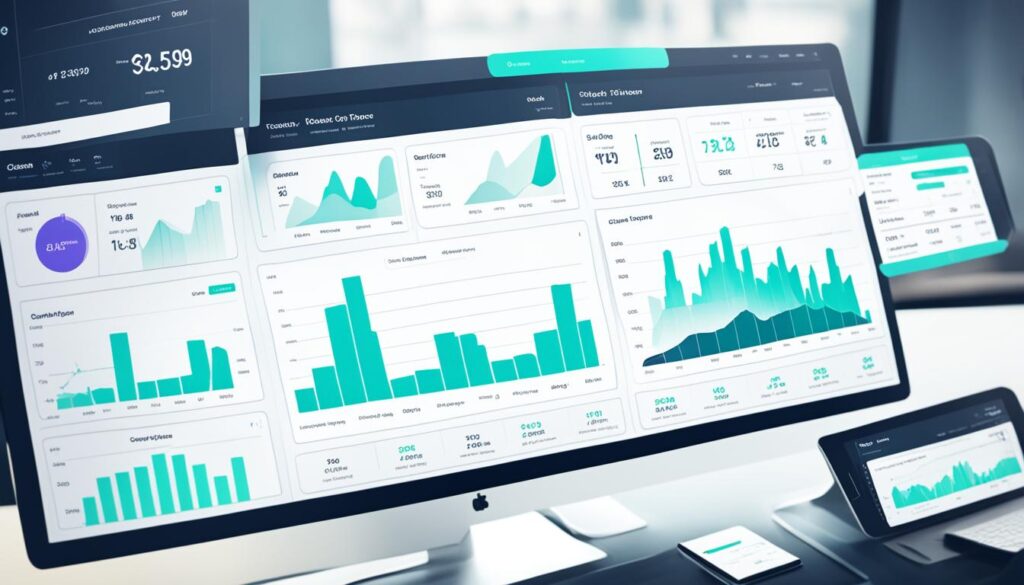“The best way to predict the future is to invent it.” This quote by Alan Kay highlights the power of AI in changing how SMEs set prices. AI and Dynamic Pricing Strategies have changed the game. They allow prices to be adjusted in real-time based on data. This ensures both higher profits and more satisfied customers.
Thanks to AI, dynamic pricing is a game-changer for SMEs. It helps them set prices perfectly by understanding market trends and what customers want. Big names like Uber and Amazon already use AI for this. They swiftly adjust prices as the market changes. This strategy boosts profits when demand is high and keeps them steady when it’s low, keeping the companies competitive all the time.
By using Automated Pricing Solutions, SMEs can change prices on the fly, thanks to AI’s quickness. Being able to shift prices instantly based on what’s happening in the market and competitors’ moves is key. It’s what makes AI-driven dynamic pricing strategies so crucial for SMEs.
Key Takeaways
- Dynamic pricing for SMEs is greatly enhanced by AI, offering real-time pricing optimization.
- AI algorithms analyze market trends and customer behavior continuously, driving informed pricing decisions.
- Companies like Uber and Amazon exemplify successful implementation of AI-driven dynamic pricing.
- AI-driven dynamic pricing not only maximizes revenue but also maintains competitiveness during off-peak periods.
- Automated pricing solutions enabled by AI allow for instantaneous price adjustments in response to market changes.
Understanding Dynamic Pricing and Its Importance for SMEs
In today’s business world, SMEs need to keep up to stay competitive. Dynamic pricing is a key strategy for this. It changes prices based on market demand, competition, and more. By using Dynamic Pricing Algorithms, businesses can respond quickly to the market. This helps them to improve their revenue and profit margins.
Definition of Dynamic Pricing
Dynamic pricing means changing prices based on several factors. These include market demand and how much supply is available. It uses AI Price Management to adjust prices in real time. This makes sure businesses stay competitive. With real-time data, SMEs can offer personalized pricing. This boosts customer satisfaction.
Why SMEs Need Dynamic Pricing
Dynamic pricing is crucial for SMEs today. With changing markets and more competition, it’s vital. Market-Responsive Pricing helps businesses make more profit when the time is right. AI-driven dynamic pricing can raise profits by 10%, according to Forrester. AI also helps adjust prices on the fly. This balances competitive prices with good profit margins. Stories from Uber and Amazon show the impact of AI on profits.
But, dynamic pricing has challenges too. It requires ethical pricing and accurate data for the right decisions. SMEs need good data collection and algorithm updates. By 2025, the value of dynamic pricing is expected to hit $10.3 billion. This shows its importance in different sectors.
Benefits of AI-Powered Dynamic Pricing for SMEs
Using Artificial Intelligence for dynamic pricing helps SMEs in many ways, like increasing profits and keeping customers happy. Small and medium businesses can do better by using these technologies in their pricing plans.
Optimized Revenue and Margins
Artificial intelligence price optimization leads to more accurate pricing. McKinsey & Company found that better pricing could boost profits by 3-5%. AI helps businesses adjust prices based on demand, which can greatly improve profit margins. Plus, these algorithmic pricing strategies can cut down the time spent analyzing data by up to 40%, as Deloitte has shown.
Real-time Adaptation to Market Changes
AI in dynamic pricing smoothly deals with changes in the market. McKinsey’s studies show AI can make pricing 20% more accurate. This means prices stay competitive and in line with the market, maximizing profits. Rapid adjustments to market shifts keep SMEs ahead without losing money.
Enhancing Customer Loyalty
AI in dynamic pricing is great because it makes prices feel personal, thanks to data-driven revenue management. It uses customer info like what they buy and like to offer tailored prices. This not only increases sales but also builds strong loyalty among customers. Invesp notes 60% of customers think price is key when buying, making targeted pricing a top strategy for keeping customers.
AI-driven dynamic pricing gives SMEs the chance to maximize profits, adapt to market changes fast, and make customers more loyal. These advantages come from smart algorithms that ensure businesses make money while offering great deals to customers.
| Benefit | Impact |
|---|---|
| Optimized Revenue and Margins | 3-5% increase in profits (McKinsey & Company) |
| Real-time Adaptation to Market Changes | Up to 20% improvement in price accuracy (McKinsey & Company) |
| Enhancing Customer Loyalty | 60% of customers rate price as a critical factor (Invesp) |
How AI Transforms Dynamic Pricing Strategies in SMEs
Artificial Intelligence changes how small and medium enterprises (SMEs) set prices. It uses Real-Time Market Analysis to quickly respond to what the market needs. This means AI looks at live data to help find trends and see how customers act.
Real-time Data Analysis
AI lets SMEs make smart pricing choices by looking at live market, demand, and trend data. This means businesses can change their prices fast to make more money. Using AI for this kind of analysis puts them ahead, as prices reflect what’s happening in the market now.
Competitor Monitoring
Keeping an eye on competitors’ prices is key with AI. It tracks what others charge, so SMEs can stay competitive. This helps SMEs not to be priced out by others, while also keeping their profits high. Companies like Uber and Amazon use AI to stay leaders by always adjusting prices.
Personalized Pricing
AI is great at setting prices based on what each customer likes and buys. This means prices can be set for every customer’s needs, making them happier and more loyal. By doing this, SMEs make offers that really speak to their customers, building strong relationships.
Here are some important points about using AI in pricing for SMEs:
| Feature | Benefit |
|---|---|
| Real-Time Data Analysis | Informs pricing decisions and adapts to market conditions |
| Competitor Monitoring | Ensures competitive pricing and avoids undercutting |
| Personalized Pricing | Enhances customer loyalty and satisfaction |
AI-driven pricing is vital for SMEs to make more profit and stay ahead. It helps with quickly analyzing the market, watching competitors, and setting personal prices. This means SMEs can handle the fast-changing market and meet what customers want.
Dynamic Pricing Strategies with AI
Today’s market is fast-changing, and small to medium businesses can gain a lot by using dynamic pricing with AI. This tech lets us analyze mountains of data to figure out demand and adjust prices right away. It helps us make smart pricing plans tailored to what our customers need.

AI-driven pricing looks at market demand, competitors, and how consumers act. This way, we can set prices that boost sales and make customers happy. For example, changing prices based on how much we have in stock prevents having too much or too little. This makes our business run better and increases our profits.
With AI, small businesses can change prices quickly to keep up with their rivals. AI also helps us understand our customers better, letting us offer deals that fit them personally based on their past buys and preferences.
Using advanced data analysis, like machine learning, improves our business. It makes our pricing more accurate and competitive over time. Testing different pricing models regularly helps us find the best approach for the current market.
Overall, AI-driven pricing is a big win for small to medium businesses. It helps us earn more, especially during busy times, and keep our profits strong. We can quickly adapt to changes in the market and make our customers more loyal with deals just for them. By always tweaking our AI, we stay on top with precise pricing, helping our business grow.
Implementing Dynamic Pricing Algorithms
Adding dynamic pricing to SMEs means combining various data into the AI system smoothly. These methods let prices change with the market in real-time, thanks to AI. It’s popular too, with 15 weekly articles on AI in pricing.
Gathering and Integrating Data
Starting with Dynamic Pricing Data Integration is key. It’s how SMEs keep up with market changes. They collect lots of data: past sales, current demand, and what competitors charge. This data helps set prices that adjust with the market, thanks to AI. Big companies like Uber and Amazon show how it’s done right.
Selecting Suitable AI Tools
Picking the right AI Tool Selection for Pricing matters a lot for an SME’s needs. Companies look at how these tools deal with big data, work in real-time, and fit into their current systems. Choosing wisely is crucial for a pricing strategy that keeps a business competitive and nimble.
Training and Calibrating Algorithms
The last step is Pricing Algorithm Training and tweaking to stay current. This means making algorithms understand the business and improve them constantly. Keeping an eye on the strategy and adjusting to the market is needed to keep prices right. Solving problems like data accuracy and ethics is important for fair prices.
Overcoming Challenges in AI-Driven Dynamic Pricing
AI-driven dynamic pricing has changed many industries by boosting profits and adaptability. Yet, it faces challenges. Accuracy in data and ethical practices are key issues. They must be solved to fully benefit from AI in pricing.

Ensuring Data Accuracy
Data accuracy is crucial for AI pricing tools. Data accuracy in price optimization affects the AI’s pricing decisions. Good data lets AI adjust prices based on the market, demand, and competitors. A study found hotels with AI pricing saw a 9.1% revenue increase. This shows how vital reliable data is.
Ethical Considerations
Making ethical AI pricing models is essential for customer trust. Pricing fairness is central to these strategies. Regular checks must be done to remove biases, ensuring fair pricing. For example, ethical AI use led to over 30% revenue growth for some in hospitality. AI must be used cautiously to prevent bias and keep prices fair. This protects the company’s image and customer trust.
Case Studies: Successful AI-Driven Dynamic Pricing
Using AI in dynamic pricing strategies has significantly boosted revenue across different industries. In the hospitality industry, AI helps adjust prices in real time. This is based on market demand, special events, and what competitors are charging. About 72% of leaders in this sector are looking to use AI for managing revenue, says PwC.
AI dynamic pricing led to a 9.1% increase in hotel revenues. Hotels that adopted AI strategies saw a more than 30% growth in RevPAR. This growth comes from AI’s ability to react to market changes instantly.
These successes are built on a type of technology architecture that’s both flexible and scalable. It’s called modular microservices architecture. It’s perfect for the fast-paced needs of today’s hospitality world. Also, using AI models on the cloud adds scalability, better security, and cost savings.
Explaining how AI makes decisions, known as Explainable AI (XAI), also played a big role. It helps users trust the AI’s pricing decisions. The use of detailed historical and current data is essential too. It includes all sorts of info, from booking rates to who’s staying and what competitors are doing.
For a smooth start, it’s wise to link AI with current revenue and property management systems. Trying out AI pricing advice on a few hotels first can also help. It allows for fine-tuning before a full-scale launch.
AI-driven pricing is not just for the hospitality industry anymore. It’s an example for all sectors. By keeping AI models up to date and listening to feedback, small and medium businesses can also see big revenue gains. AI has become a crucial tool for staying competitive and growing in the market.
| AI Features | Benefits |
|---|---|
| Real-time Data Analysis | Provides up-to-date market insights |
| Competitor Monitoring | Ensures competitive edge |
| Personalized Pricing | Enhances customer satisfaction and loyalty |
| Cloud Deployment | Scalability, security, and cost-efficiency |
| Explainable AI | Builds user trust in pricing decisions |
The Role of Machine Learning in AI-Driven Pricing Models
Machine learning has changed AI-driven pricing models a lot. It helps in improving revenue management and knowing customer groups better. With smart algorithms, small and medium-sized enterprises (SMEs) can set prices more wisely. They consider market trends and how consumers act.

Predictive Analytics for Revenue Management
Adding machine learning to pricing strategies lets businesses use predictive analytics in pricing. This lets SMEs look at old and new data to guess future patterns. It makes managing income better and more efficient. By always learning from customer data, these models give insights that really help with important business measures (KPIs).
Price Elasticity and Demand Forecasting
Advanced AI-based demand forecasting is key in understanding price elasticity. It’s about how price changes impact how much of a product or service is wanted. Machine learning can guess how demand will change based on things like time of year, competitors, and events. This helps in setting smart prices. And it’s done in a way that makes both money and customers happy.
Personalized Customer Segmentation
Machine learning pricing models are great for personalized customer segmentation. They look at each customer’s buying history and actions. Then, machine learning makes special pricing plans for different customer groups. This makes customers more loyal. It also leads to more sales and profit.
Best Practices for Implementing AI-Powered Pricing Strategies
Retailers start by setting clear goals for their AI pricing, like making more money or focusing on profit. Using AI helps them set the right prices and keep improving them. This means always checking and adjusting how they set prices.
When retailers switch to AI from old pricing methods, they see better sales, profits, and how customers see their value. Keeping an eye on competitors’ prices is key. It helps adjust prices to stay competitive in the market.
Running regular tests and analyzing results is vital for making more money with AI pricing. Good data and algorithms that get better over time are needed for this. Companies using AI for pricing have seen profits go up by 5% to 10%.
AI pricing also makes revenues go up and improves how customers see value. For example, a big retailer in the US made customers 10% happier by lowering prices on important items when prices were rising everywhere.
Using AI for pricing needs a dedicated team with the right knowledge. They use advanced tools to set prices that match local markets. This makes pricing methods better.
Retailers need to decide if they’ll create their AI tools, buy them, or work with others. Choosing the right prices between branded and own products affects what customers buy and keeps profits up. Prices should be clear and make sense to customers.
Being open about how prices are set keeps customers’ trust. Keeping up with market changes is essential for staying ahead with AI pricing. Following these tips, retailers can face market challenges and be profitable in the long run.
Read more about overcoming retail complexity with AI-powered pricing
Future Trends in AI-Powered Dynamic Pricing
The future of AI-powered dynamic pricing looks exciting for small and medium businesses. Thanks to better machine learning algorithms, companies will handle bigger, complex data sets. This means they can set prices more accurately, giving them an edge in today’s fast-paced market. With smarter AI, businesses can predict trends and adjust prices ahead of time.
Soon, AI will work together with Internet of Things (IoT) devices. This will allow for instant data gathering and price changes based on what’s happening in the market and how consumers behave. Predictive analytics will improve demand forecasting. This helps businesses manage their stock better and keep customers happy. As these tools get easier to use, even small businesses can compete with bigger ones.
But, adopting these new pricing methods has its challenges. There are concerns about data privacy and the need for experts who can understand AI data. Also, it’s important to watch out for algorithm bias to ensure prices are fair. As rules change, companies must keep up to not break any laws while using AI to set prices. AI’s rapid development lets businesses quickly adapt to new market trends.



